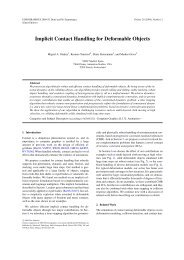Perceiving affordances in virtual reality: Influence of person ... - GMRV
Perceiving affordances in virtual reality: Influence of person ... - GMRV
Perceiving affordances in virtual reality: Influence of person ... - GMRV
You also want an ePaper? Increase the reach of your titles
YUMPU automatically turns print PDFs into web optimized ePapers that Google loves.
Fig. 3 Mean percentage <strong>of</strong> “yes” responses (the surface would support upright stance) as a function<br />
<strong>of</strong> angle <strong>of</strong> <strong>in</strong>cl<strong>in</strong>ation <strong>of</strong> the slanted surface. Bars represent SD.<br />
To get an accurate measure <strong>of</strong> the critical angle, the percentage <strong>of</strong> “yes” responses<br />
for each angle <strong>of</strong> <strong>in</strong>cl<strong>in</strong>ation was analyzed us<strong>in</strong>g a logistic function expressed by<br />
the follow<strong>in</strong>g equation (Bootsma et al. 1992; O’Regan and Humbert 1989; Peper<br />
et al. 1994; Cornus et al. 1999):<br />
% <strong>of</strong> " yes"responses<br />
=<br />
100<br />
−k(<br />
c−x)<br />
( 1 + e )<br />
In the logistic equation, 100% was the maximum percentage <strong>of</strong> “yes” responses<br />
(i.e., the participants always judged to be able to stand on the slanted surface), x,<br />
the angle <strong>of</strong> <strong>in</strong>cl<strong>in</strong>ation <strong>in</strong> degrees. C was the 50% po<strong>in</strong>t, that is, the angle <strong>of</strong> the<br />
slanted surface at which the participant changed his or her judgment from “yes, I<br />
can stand on the slanted surface” to “no, I can’t”. In other words, this po<strong>in</strong>t was<br />
the critical angle for stand<strong>in</strong>g on the slanted surface with an upright posture. K<br />
was the slope approach<strong>in</strong>g that po<strong>in</strong>t. The analysis revealed that the 50% po<strong>in</strong>t<br />
occurred at an angle <strong>of</strong> <strong>in</strong>cl<strong>in</strong>ation <strong>of</strong> 21.98° (k = 0.32; r² = 0.84) with lower and<br />
upper fiducial limits <strong>of</strong> 21.06° and 22.91°.<br />
4.5.2 Analysis on Response Time<br />
For each participant, the mean response time (<strong>in</strong> seconds) was computed on the 6<br />
trials for each angle <strong>of</strong> <strong>in</strong>cl<strong>in</strong>ation. A 7 (Angle <strong>of</strong> <strong>in</strong>cl<strong>in</strong>ation) repeated-measures<br />
ANOVA on the mean response time showed a significant ma<strong>in</strong> effect, F(6,66)<br />
= 9.23, p < 0.001 (see Fig. 4), <strong>in</strong>dicat<strong>in</strong>g that participants took longer to explore<br />
surfaces close to the transition po<strong>in</strong>t between support<strong>in</strong>g and not support<strong>in</strong>g<br />
upright posture. Mean response times for the seven angles <strong>of</strong> <strong>in</strong>cl<strong>in</strong>ation were<br />
3.15, 4.93, 5.29, 4.14, 3.47, 2.84, and 2.48 s, respectively.<br />
10





